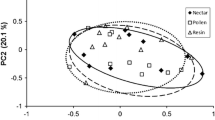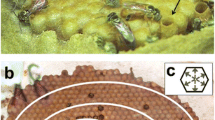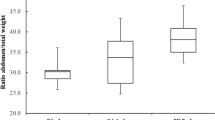Abstract
Although variation in body size has been recently reported in stingless bees (Meliponini), empirical evidence evaluating possible factors related to such variation is lacking, and thus it is not clear if it may have an adaptive significance. We evaluated if variation in the body size and weight of workers of stingless bees fluctuates across a seasonal pattern and if this could be related to characteristics of the food consumed during the larval stage. The weight of larval provisions, their protein, and sugar content were evaluated in four colonies of Nannotrigona perilampoides every 2 months across 1 year. Worker-destined larvae from the same combs were allowed to develop and were sampled as callow workers to determine their weight and size using morphometric data. The weight and size of workers were highly correlated and varied across the seasons in established colonies, suggesting that size variation cycles across the year in stingless bees. An increase in the protein content and, to a lesser degree, the quantity of larval food were positively linked to variation in body weight and size; food with richer protein content resulted in larger and heavier workers. This study provides the first evidence of an effect of the quantity and composition of larval food on the size of workers in stingless bees. Although body weight and size of workers differed across seasons, they were not readily noticeable as changes seem to occur as a continuum across the year. Since size polymorphism was of a larger magnitude across time but not within age cohorts and as it was highly determined by food resources, it may not be an adaptive feature in stingless bees. However, more studies are needed to determine the role of the cyclical change in worker body size on colony performance and thus its adaptive significance in stingless bees.





Similar content being viewed by others
References
Alves D.A., Imperatriz-Fonseca V.L. and Santos-Filho P.S. 2009. Production of workers, queens and males in Plebeia remota colonies (Hymenoptera, Apidae, Meliponini), a stingless bee with reproductive diapauses. Gen. Mol. Res. 8: 672-683
Ayala R. 1999. Revisión de las abejas sin aguijón de México (Hymenoptera: Apidae: Meliponini). Folia Entomol. Mex. 106: 1-123
Biesmeijer J.C., Born M., Lukacs S. and Sommeijer M.J. 1999. The response of the stingless bee Melipona beecheii to experimental pollen stress, worker loss and different levels of information input. J. Apic. Res. 38: 33-41
Blanckenhorn W.U. 2009. Causes and consequences of phenotypic plasticity in body size: the case of the yellow dung fly Scathophaga stercoraria (Diptera: Scathophagidae) In: Phenotypic Plasticity of Insects: Mechanism and Consequences (Whitman D.W. and Ananthakrishnan T.N., Eds) Enfield NH, USA. pp 369-422
Bosch J. and Vicens N. 2006. Relationship between body size, provisioning rate, longevity and reproductive success in females of the solitary bee Osmia cornuta. Behav. Ecol. Sociobiol. 60: 26-33
Bradford M.M. 1976. A rapid and sensitive method for the quantitation of microgram quantities of protein utilizing the principle of protein-dye binding. Anal. Biochem. 72: 248-254
Bullock S.H. 1999. Relationships among body size, wing size and mass in bees from a tropical dry forest in Mexico. J. Kansas Entomol. Soc. 72: 426-439
Cameron S. 1993. Multiple origins of advanced eusociality in bees inferred from mitochondrial DNA sequences. Proc. Natl Acad. Sci. USA 90: 8687-8691
Cameron S.A. and Mardulyn P. 2001. Multiple data sets suggest independent origins of highly eusocial behavior in bees (Hymenoptera: Apinae). Syst. Biol. 50: 194-214
Cane J.H. 1987. Estimation of bee size using intertegular span (Apoidea). J. Kansas Entomol. Soc. 60:145-147
Chapman R.F. 1998. The Insects: Structure and Function. Cambridge, Univ. Press, UK. 770 pp
Couvillon M.J. and Dornhaus A. 2010. Small worker bumble bees (Bombus impatiens) are hardier against starvation than their larger sisters. Insect. Soc. 57: 193-197
Couvillon M.J., Jandt J.J., Duong N. and Dornhaus A. 2010. Ontogeny of worker body size distribution in bumble bee (Bombus impatiens) colonies. Ecol. Entomol. 35: 424-435
Engels W. and Imperatriz-Fonseca V.L. 1990. Caste development, reproductive strategies and control of fertility in honey bees and stingless bees. In: Social Insects an Evolutionary Approach to Castes and Reproduction (Engels W., Ed). Springer, Berlin. pp 166-230
Flores J.S. 1990. The flowering periods of Leguminosae in the Yucatan peninsula in relation to honey flows. J. Apic. Res. 29: 82-88
Goulson D., Peat J., Stout J., Tucker J., Darvill B., Derwent L.C. and Hughes W.O.H. 2002. Can alloethism in workers of the bumblebee, Bombus terrestris, be explained in terms of foraging efficiency? Anim. Behav. 64: 123-130
Goulson D., Derwent L.C. and Peat J. 2005. Evidence for alloethism in stingless bees (Meliponinae). Apidologie 36: 411-412
Hartfelder K. and Engels W. 1989. The composition of larval food in stingless bees: evaluating nutricional balance by chemosystematic methods. Insect. Soc. 36: 1-14
Hartfelder K. and Engels W. 1992. Allometric and multivariate analysis of sex and caste polymorphism in the neotropical stingless bee, Scaptotrigona postica. Insect. Soc. 39: 251-266
Hölldobler B. and Wilson E.O. 1990. The Ants. Harvard University Press, Cambridge, Mass. 732 pp
Huang Z. and Otis G.W. 1991. Inspection and feeding of larvae by worker honey bees (Hymenoptera: Apidae): effect of starvation and food quantity. J. Insect Behav. 4: 305-317
Johnson M.D. 1990. Female size and fecundity in the small carpenter bee, Ceratina calcarata (Robertson) (Hymenoptera: Antophoridae). J. Kansas Entomol. Soc. 63: 414-419
Kolmes S.A. and Sam Y. 1991 Relationship between sizes of morphological features in worker honey bees (Apis mellifera). J. N.Y. Entomol. Soc. 99: 684-690
Klostermeyer E.C., Mech J.S. Jr. and Rasmussen W.B. 1973. Sex and weight of Megachile rotundata (Hymenoptera: Megachilidae) progeny associated with provision weights. J. Kansas Entomol. Soc. 46: 536-548
León-Contrera F.A., Imperatriz-Fonseca V.L. and Koedam D. 2006. Age-dependent mass variation in the stingless bee Melipona quadrifasciata (Apidae, Meliponini). Braz. J. Morphol. Sci. 23: 321-324
Medan V. and Josens R.B. 2005. Nectar foraging behaviour is affected by ant body size in Camponotus mus. J. Insect Physiol. 51: 853-860
Moo-Valle H., Quezada-Euán J.J.G. and Wenseleers T. 2001. The effect food reserves on the production of sexual offspring in the stingless bee Melipona beecheii (Apidae: Meliponini). Insect. Soc. 48: 398-403
Moo-Valle H., Quezada-Euán J.J.G., Canto-Martín J. and González-Acereto J.A. 2004. Caste ontogeny and distribution of reproductive cells on the combs of Melipona beecheii (Apidae: Meliponini). Apidologie 35: 587-594
Nazzi F. 1992. Morphometric analysis of honey bees from an area of racial hybridization in northeastern Italy. Apidologie 23: 89-96
Pendrel B.A. and Plowright R.C. 1981. Larval feeding by adult bumble bee workers (Hymenoptera: Apidae). Behav. Ecol. Sociobiol. 8: 71-76
Pignata M.I.B. and Diniz-Filho J.A.F. 1996. Spatial autocorrelation and evolutionary constraints in worker body size of some Neotropical stingless bees (Hymenoptera: Apidae). Heredity 76: 222-228
Quezada-Euán J.J.G., May-Itzá W.J., Valladares P. and De la Rúa P. 2008. Variación fenotípica en obreras y su relación con la producción de miel en colonias de Melipona beecheii B. (Hymenoptera:Meliponini). In: Memorias V Congr. Mesoamericano Abejas sin Aguijón. Univ. Aut. Yucatán. pp 106-112
Ramalho M., Imperatriz-Fonseca V.L. and Giannini T.C. 1998. Within-colony size variation of foragers and pollen load capacity in the stingless bee Melipona quadrifasciata anthidioides Lepeletier (Apidae, Hymenoptera). Apidologie 29: 221-228
Ribeiro M.F. 1994. Growth in bumble bee larvae: relation between development time, mass, and amount of pollen ingested. Can. J. Zool. 72: 1978-1985
Ribeiro M.F., Velthuis H.H.W., Duchateau M.J. and Tweel I. van D. 1999. Feeding frequency and caste differentiation in Bombus terrestris larvae. Insect. Soc. 46: 306-314
Richards M.H. and Packer L. 1996. The sociology of body size variation in the primitively eusocial sweat bee Halictus ligatus (Hymenoptera: Halictidae). Oikos 77: 68-76
Roubik D.W. 1982. Seasonality in colony food storage, brood production and adult survivorship: studies of Melipona in tropical forest (Hymenoptera: Apidae). J. Kansas Entomol. Soc. 55: 189-800
Roulston T.H. and Cane J.H. 2000. The effect of diet breadth and nesting ecology on body size variation in bees (Apoidea). J. Kansas Entomol. Soc. 73: 129-142
Roulston T.H. and Cane J.H. 2002. The effect of pollen protein concentration on body size in the sweat bee Lasioglossum zephyrum (Hymenoptera: Apiformes). Evol. Ecol. 16: 49-65
SAS 2002. Ver. 9. SAS Institute, Cary, NC
Smith B.H. and Weller C. 1989. Social competition among gynes in halictine bees: the influence of bee size and pheromones on behavior. J. Insect Behav. 2: 397-411
Sommeijer M.J., Rooijakkers E.F., Jacobusse C. and Kerkvliet J.D. 2009. Larval food composition and food plants of the solitary bee Colletes halophilus (Hymenoptera: Colletidae). J. Apic. Res. and Bee World 48: 149-155
Slaa E.J. 2006. Population dynamics of a stingless bee community in the seasonal dry lowlands of Costa Rica. Insect. Soc. 53: 70-79
Spaethe J. and Weidenmüller A. 2002. Size variation and foraging rate in bumblebees (Bombus terrestris). Insect. Soc. 49: 142-146
Van der Moezel P.G., Delfs J.C., Pate J.S., Loneragan W.A. and Bell D.T. 1987. Pollen selection by honeybees in shrublands of the Northern Sandplains of Western Australia. J. Apic. Res. 26: 224-232
Velthuis H.H.W., Cortopassi-Laurino M., Pereboom Z. and Imperatriz-Fonseca V.L. 2003. Speciation, development, and the conservative egg of the stingless bee genus Melipona. Proc. Exper. Appl. Entomol. NEV Amsterdam 14: 53-57
Waddington K.D., Herbst L.H. and Roubik D.W. 1986. Relationship between recruitment systems of stingless bees and within-nest worker size variation. J. Kansas Entomol. Soc. 59: 95-102
Wiley E.O. 1981. Phylogenetics: the Theory and Practice of Phylogenetic Systematics. Wiley, New York. 456 pp
Zobel M. and Paxton R.J. 2007. Is big the best? Queen size, usurpation and nest closure in a primitively eusocial sweat bee (Lasioglossum malachurum). Behav. Ecol. Sociobiol. 61: 435-447
Acknowledgments
This work was supported by grant CONACYT-SAGARPA-2002-C01-1556/A-1. We thank Dr. Rogelio Alonso Morales and the Universidad Nacional Autónoma de México (UNAM) for the facilities to perform the analyses of food quality. ALV’s MSc studies were supported by grant CONACYT 206972. We are also grateful to Dr. Luis Rodriguez for statistical suggestions.
Author information
Authors and Affiliations
Corresponding author
Electronic supplementary material
Below is the link to the electronic supplementary material.
Rights and permissions
About this article
Cite this article
Quezada-Euán, J.J.G., López-Velasco, A., Pérez-Balam, J. et al. Body size differs in workers produced across time and is associated with variation in the quantity and composition of larval food in Nannotrigona perilampoides (Hymenoptera, Meliponini). Insect. Soc. 58, 31–38 (2011). https://doi.org/10.1007/s00040-010-0113-2
Received:
Revised:
Accepted:
Published:
Issue Date:
DOI: https://doi.org/10.1007/s00040-010-0113-2




